Paddle Float Stirrup Recovery
This variation of the paddle float recovery is designed for paddlers who have difficulty climbing onto the back deck of their kayak thus creating the need for some assistance for this solo recovery. The concept behind this variation is borrowed from a horse back riding saddle. The use of a stirrup hanging down into the water, to provide a step up, can give the needy paddler the lift they need to get their body out of the water and onto the back deck.
The use of the stirrup was originally designed for use in cold water thinking leg and thigh muscles may still be functional when an immersed paddler was getting hypothermic and had to get out of the water. It can also be used for an injured paddler (one who cannot use upper limb very much) aside from a paddler that just needs that leg power to get up.
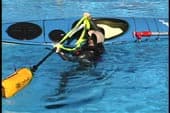
When this variation was first developed paddle shafts were a lot stronger than some of the new light weight paddles on the market today. I don't know a fool proof way of determining if your light weight paddle shaft can take the stress of this recovery method. This is another reason why I have a two paddle philosophy. One for heavy duty and one for light weight needs.
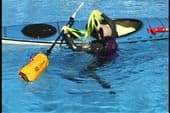
I recommend you review the standard paddle float recovery and stirrup recoveries (assisted) before reading about this variation using a stirrup when solo. We begin this variation after the paddle float is on the paddle and inflated (if an inflatable one is used). The stirrup is looped over the end of the paddle opposite the paddle float.
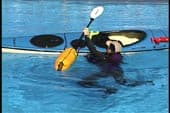
Hold the paddleshaft near the throat of the paddle and the stirrup (which is now on the paddleshaft) in the same hand. The remainder of the stirrup is tossed over the kayak (with the other hand) onto the far side into the water. If you don't hold onto the stirrup as mentioned, it is possible to have the entire stirrup fly off of the paddle. After doing this a few times it gets easy. The first time is like playing with wet spaghetti (or fettuccini for you purists).
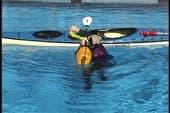
Once the stirrup is in the water on the far side, start pushing the kayak toward the stirrup and the stirrup will come up on your side of the kayak. Trying to reach under without pushing the kayak takes too much time and your goal is to minimize immersion time.
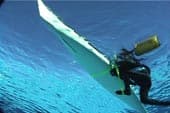
As you pull the stirrup under the kayak and up on your side the stirrup cinches around the hull of your kayak with the paddle shaft over the deck behind the cockpit coaming. Next you wrap the stirrup over and around your side of the paddle shaft. The length of the stirrup is adjusted by the number of times you wrap the stirrup around the paddle shaft. The last wrap should be done on the inside (between the kayak and the stirrup wraps. This inside last wrap keeps the stirrup from sliding down the shaft when you step on it. If the stirrup slides too far from the kayak down the shaft more stress is put on the shaft.
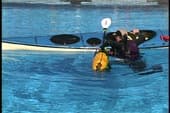
When you have the stirrup at the proper length use your hand to help guide the stirrup onto your foot. As you face toward the stern end of the kayak the outside foot is the one you place into the stirrup. If the stirrup is too long you will not get high enough out of the water. If it is too short your knee will be too bent to allow you to climb up. You need to experiment and find the Goldilocks length which is "juuust right."

When you have your foot in the stirrup you need to get your upper body over your foot and your foot (the one in the stirrup) pushing down and out away from the kayak. If you push your foot under the kayak toward the other side you will not be able to get your foot under your body which is needed to give you the support you are trying to get.
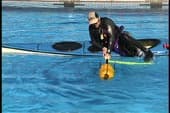
As you step down on the stirrup one hand is pressing onto the paddle shaft and the other on the far side of the cockpit coaming. Your goal is to step up and lay on your back deck.
When you are laying on your back deck you place your free foot into the cockpit. As always, you are keeping you balance point toward the paddle float. Your body weight is on your kayak.
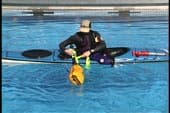
As you begin to twist and bring your second foot into the cockpit it is vital you shake the stirrup off of your foot before it leaves the water. (If your foot slipped through the stirrup it would be looped around your lower limb as you tried to finish the maneuver. This can be a very nasty tangle. The best way to untangle is to slip that looped leg into the water and get your foot out of the stirrup.)
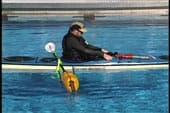
Once you are seated in your cockpit you will want to attach your spray skirt onto the coaming and then pump out the water. You can tie off the stirrup onto the paddle shaft (if you are good with slip knots and you are flexible enough to twist and tie) which gives you a nice outrigger with both hands free to do secure spray skirt and pump. You would undo the stirrup once the pumping is complete and the pump is restowed.
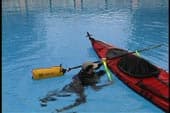
I prefer to not use a slip knot so I undo the stirrup and then bring the paddle in front of me. Regardless of which way works best for you, at this point you are back to the sequence in the traditional paddle float recovery.
If your back deck is a peaked deck (which is common with folding kayaks) you should realize the stress on the paddle shaft is concentrated at that peak. The flatter the back deck the less chance there is of breaking your paddle. If you have a peaked rear deck and need the stirrup option consider keeping a very heavy duty paddle just for this occasion.
Another variation on this variation is looping the stirrup around the cockpit coaming as seen in the assisted stirrup recoveries. However, your paddle needs to be under back deck rigging to hold it in place as you step down on your stirrup. The back deck rigging needs to be very secure and not allow much give. Most shock cord rigging is too flexible to use this coaming variation. Try it in calm water to see if your rigging will give your paddle the support you need. (See the deck rigging variation mentioned in the traditional paddle float recovery.)
I use universal stirrup discussed in the stirrup recovery page. I know of a few paddlers who made stirrups just for their kayak and secured them inside their cockpit. When they needed to get back in they just pulled the pre-attached stirrup out from the cockpit and it hung the perfect length into the water and then climbed back in. They us it primarily for assisted recoveries when someone else it holding their kayak steady. If they were to try a solo recovery with their custom stirrup setup they would need secure deck rigging to hold their paddle in place.
Of course if you could not climb onto the back deck another option that takes much less energy is the re-enter and roll with a paddle float. Once you get the hang of it you will be eager to use it instead of climbing out of the water.
As always, you need to practice this and all recoveries repeatedly if you want to count on using them in real conditions. One cannot practice too much. The more you practice the more proficient you will become.
Wayne Horodowich, founder of The University of Sea Kayaking (USK), writes monthly articles for the USK web site. In addition, Wayne has produced the popular "In Depth" Instructional Video Series for Sea Kayaking.
Related Articles
Last month we discussed how to detect and patch (not "repair") a leak on a typical roto-molded kayak…
A kayaker should have a number of recovery methods to choose from in their bag of skills. I feel the…
It is always good to have a few different ways to perform a capsize recovery. The main solo recovery…
Watch this short tutorial video on the Continuous Greenland Roll with useful underwater shots and a…

